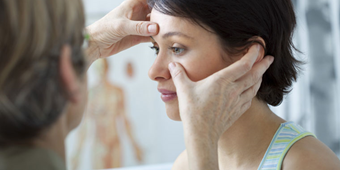Changes In Breast Composition Usually Not Sign Of Cancer

Answer a few questions and we'll provide you with a list of primary care providers that best fit your needs.
If you detect a change in your breast composition, you may naturally jump to the conclusion that it’s a sign of cancer, but a local surgeon says it could signal a less threatening condition.
Thomas Heck, MD says it’s important to understand that your breasts will undergo changes throughout your lifetime:
Click play to watch the video or read video transcript.
The ever-increasing awareness of breast cancer has served a positive role in helping women understand the importance of regular screening as well as contacting their physician when they suspect a change in their breasts. But most breast changes are not cancer, and the majority of biopsied lumps in breasts are benign – or non-cancerous.
Seeking medical attention for any breast change is extremely important and, while it may not be cancerous, it could indicate one of several non-cancerous breast diseases. Dr. Heck describes changes in your breasts that you should take seriously:
Click play to watch the video or read video transcript.
“Most conditions are diagnosed based on a physical exam or picked up in imaging studies like a mammogram or ultrasound,” says Dr. Heck. “In some cases these conditions will require a biopsy to confirm there is no presence of cancer, and depending on those findings will determine if the non-cancerous condition places the woman at a higher risk of developing breast cancer at a later time.”
Three Common Non-Cancerous Breast Conditions
There are similarities and differences among the three most common non-cancerous breast conditions. Here’s how Dr. Heck explains it:
- Cysts of the breast. Cysts are fluid-filled sacs that are almost always benign, but that often cause much discomfort or pain in a woman’s breast. Women who have cysts may complain of extreme pain simply by turning over in bed at night. Women can receive relief from the pain by having the cyst drained by a physician.
- Fibroadenomas. Fibroadenomas are solid, benign tumors that most commonly appear in women 15 to 33 years of age. This condition rarely increases a woman’s risk of developing breast cancer and does not need to be removed unless they grow to a size that affects a woman’s quality of life.
- Hyperplasia. Hyperplasia is an overgrowth of cells in a woman’s breast tissue – most commonly inside the lobules or milk ducts. There are two different types of hyperplasia, both of which can increase a woman’s risk of breast cancer. A woman diagnosed with atypical hyperplasia increases her risk for breast cancer up to three to four times of the normal risk.
Any woman can develop a non-cancerous breast condition, however, studies have found certain factors may increase or lower her risk. According to the Susan G. Komen Foundation, menopausal hormone therapy and a family history of breast cancer or benign breast conditions may increase a woman’s risk for developing benign breast conditions. Likewise, ongoing research suggests lifestyle factors in a female’s teen years may lower risk. This includes a diet that contains carotenoids (such as melons, carrots, sweet potatoes and squash) nuts and beans.
Dr. Heck enjoys being able to put a woman’s mind at ease about the recent changes in her breast tissue.
“Women come in because they felt a lump or something was found on an imaging test. Rightfully, they are concerned and we are concerned,” Dr. Heck says. “For a lot of patients, however, once we evaluate them and do a biopsy, we are able to tell them it is not cancer. It is such a wonderful thing to see them walk out of the office as one of the most relieved patients in the world.”
For more information on non-cancerous breast conditions or find a Premier Physician Network healthcare provider near you.
Answer a few questions and we'll provide you with a list of primary care providers that best fit your needs.
Source: Thomas Heck, MD







